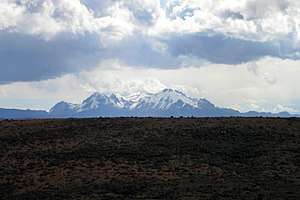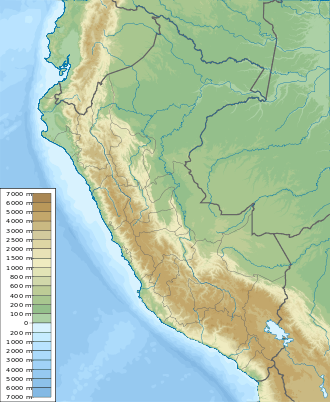Hualca Hualca
Hualca Hualca[2][3] (possibly from Aymara and Quechua wallqa collar)[4][5] is an extinct volcano[2] in Arequipa Region in the Andes of Peru. It has a height of 6,025 metres.[3]
| Hualca Hualca | |
|---|---|
 | |
| Highest point | |
| Elevation | 6,025 m (19,767 ft) |
| Coordinates | 15°43′13″S 71°51′38″W [1] |
| Geography | |
 Hualca Hualca Location of Hualca Hualca in Peru. | |
| Location | Arequipa, Peru |
| Parent range | Andes |
| Geology | |
| Mountain type | Stratovolcano |
| Volcanic arc/belt | Central Volcanic Zone |
| Last eruption | Unknown |
Hualca Hualca is part of the Central Volcanic Zone of the Andes, a volcanic belt which occurs where the Nazca Plate subducts beneath the South America Plate. Volcanoes in Peru that are part of the Central Volcanic Zone include Ampato, Casiri, Chachani, Coropuna, El Misti, Huaynaputina, Pichu Pichu, Sabancaya, Sara Sara, Solimana, Ticsani, Tutupaca, Ubinas and Yucamane.[6]

Hualca Hualca forms a volcanic complex with the two southerly volcanoes Sabancaya and Ampato. It is older (Pliocene-Pleistocene) and more heavily eroded than these two volcanoes; they are all constructed on Neogene ignimbrites, one of which was dated to 2.2 ± 1.5 million years ago.[7] The volcano has erupted andesitic lava flows; one series of such flows exceeds a thickness of 0.5 kilometres (0.31 mi).[8] Volcanic rocks of Hualca Hualca contain phenocrysts of biotite, clinopyroxene, hornblende, orthopyroxene, plagioclase and sphene. The magma probably originated through mixing processes, similar to Sabancaya.[2]
The northern flank of Hualca Hualca underwent a large sector collapse between 1.36 and 0.61 million years ago,[8] opening up a collapse amphitheatre[9] and forming a lake in the Colca valley which later catastrophically failed.[8] This lake has left lacustrine deposits in the Colca Valley.[10] Eruptions within the collapse amphitheatre generated lava flows which then formed volcanic dams in the Colca Valley.[11] Lava domes and pyroclastic flows also originated within the collapse scar.[2] Earthquakes and hydrothermal alteration probably caused the onset of the collapse event.[10]
The volcano was glaciated during the last ice age, between 18,000 and 11,500 years ago.[12] This glaciation has left moraines, rock glaciers and roches moutonees.[10] The glaciers on Hualca Hualca have retreated since then, one was reported to have disappeared by 2000.[13] Snowmelt and runoff from Hualca Hualca are sources of water for the Colca Canyon, supporting irrigated agriculture there; the mountain is worshipped by local inhabitants, who according to reports in 1586 believed that their ancestors come from it.[14]
Hualca Hualca is considered to be an extinct volcano;[6] however at least seven vents on its southwestern flank show evidence of Holocene activity.[10] Satellite images in the early 21st century found that Hualca Hualca is inflating from a depth of 13–11 kilometres (8.1–6.8 mi) at a rate of 2 centimetres per year (0.79 in/year). This deformation may be associated with the neighbouring volcano Sabancaya which is active; magma chambers of volcanoes are sometimes distant from the actual volcano as was the case with Katmai.[15] The inflation ceased after 1997.[16] At Pinchollo in the collapse scar three geysers were active in the past; one is still active as of 2013 and is named Infiernillo.[9]
Climbing
Hualca Hualca can be climbed in a few days from the village of Pinchollo by the north side.[17]
References
- "Nevado Hualca Hualca". GEOnet Names Server. Retrieved 11 August 2017.
- Burkett, B. (2005-12-01). "Volcanism at Hualca Hualca Volcano, Southern Peru". AGU Fall Meeting Abstracts. 53: V53B–1552. Bibcode:2005AGUFM.V53B1552B.
- Peru 1:100 000, Chivay (32-s). IGN (Instituto Geográfico Nacional – Perú).
as Nevado Hualca Hualca
- Radio San Gabriel, "Instituto Radiofonico de Promoción Aymara" (IRPA) 1993, Republicado por Instituto de las Lenguas y Literaturas Andinas-Amazónicas (ILLLA-A) 2011, Transcripción del Vocabulario de la Lengua Aymara, P. Ludovico Bertonio 1612 (Spanish-Aymara-Aymara-Spanish dictionary)
- Teofilo Laime Ajacopa, Diccionario Bilingüe Iskay simipi yuyayk'ancha, La Paz, 2007 (Quechua-Spanish dictionary)
- Thouret, Jean-Claude; Rivera, Marco; Wörner, Gerhard; Gerbe, Marie-Christine; Finizola, Anthony; Fornari, Michel; Gonzales, Katherine (2005-07-01). "Ubinas: the evolution of the historically most active volcano in southern Peru" (PDF). Bulletin of Volcanology. 67 (6): 557–589. Bibcode:2005BVol...67..557T. doi:10.1007/s00445-004-0396-0. ISSN 0258-8900.
- Gerbe, Marie-Christine; Thouret, Jean-Claude (2004-08-01). "Role of magma mixing in the petrogenesis of tephra erupted during the 1990–98 explosive activity of Nevado Sabancaya, southern Peru". Bulletin of Volcanology. 66 (6): 541–561. doi:10.1007/s00445-004-0340-3. ISSN 0258-8900.
- Zerathe, Swann; Lacroix, Pascal; Jongmans, Denis; Marino, Jersy; Taipe, Edu; Wathelet, Marc; Pari, Walter; Smoll, Lionel Fidel; Norabuena, Edmundo (2016-09-15). "Morphology, structure and kinematics of a rainfall controlled slow‐moving Andean landslide, Peru". Earth Surface Processes and Landforms. 41 (11): 1477–1493. Bibcode:2016ESPL...41.1477Z. doi:10.1002/esp.3913. ISSN 1096-9837.
- Ciesielczuk, Justyna; Żaba, Jerzy; Bzowska, Grażyna; Gaidzik, Krzysztof; Głogowska, Magdalena (March 2013). "Sulphate efflorescences at the geyser near Pinchollo, southern Peru". Journal of South American Earth Sciences. 42: 186–193. Bibcode:2013JSAES..42..186C. doi:10.1016/j.jsames.2012.06.016.
- Alcalá-Reygosa, Jesús; Palacios, David; Orozco, José Juan Zamorano (2016-10-19). "Geomorphology of the Ampato volcanic complex (Southern Peru)". Journal of Maps. 12 (5): 1160–1169. doi:10.1080/17445647.2016.1142479.
- Silva, SL de; Francis, P. W. (1990-03-01). "Potentially active volcanoes of Peru-Observations using Landsat Thematic Mapper and Space Shuttle imagery". Bulletin of Volcanology. 52 (4): 286–301. Bibcode:1990BVol...52..286D. doi:10.1007/BF00304100. ISSN 0258-8900.
- Alcalá, Jesus; Palacios, David; Vazquez, Lorenzo; Juan Zamorano, Jose (2015-04-01). "Timing of maximum glacial extent and deglaciation from HualcaHualca volcano (southern Peru), obtained with cosmogenic 36Cl". Egu General Assembly Conference Abstracts. 17: 12930. Bibcode:2015EGUGA..1712930A.
- Alcalá, Jesus; Palacios, David; Juan Zamorano, Jose (2015-04-01). "Reconstruction of glacial changes on HualcaHualca volcano (southern Peru) from the Maximum Glacier Extent to present". Egu General Assembly Conference Abstracts. 17: 13492. Bibcode:2015EGUGA..1713492A.
- Boelens, Rutgerd; Gelles, Paul H. (2005-07-01). "Cultural Politics, Communal Resistance and Identity in Andean Irrigation Development". Bulletin of Latin American Research. 24 (3): 311–327. doi:10.1111/j.0261-3050.2005.00137.x. ISSN 1470-9856.
- Pritchard, Matthew E.; Simons, Mark (2002-07-11). "A satellite geodetic survey of large-scale deformation of volcanic centres in the central Andes". Nature. 418 (6894): 167–171. Bibcode:2002Natur.418..167P. doi:10.1038/nature00872. ISSN 0028-0836. PMID 12110886.
- Pritchard, Matthew E.; Simons, Mark (2004). "Surveying Volcanic Arcs with Satellite Radar Interferometry" (PDF). GSA Today. 14 (8): 4. doi:10.1130/1052-5173(2004)014<4:svawsr>2.0.co;2.
- Biggar, John (2020). The Andes - A Guide for Climbers and Skiers (5th ed.). p. 182. ISBN 978-0-9536087-6-8.